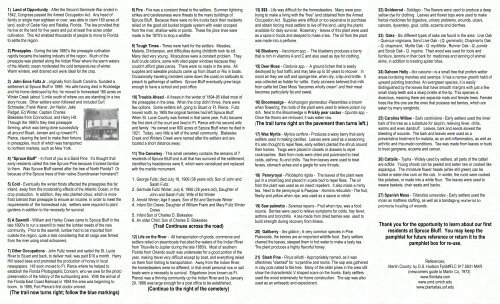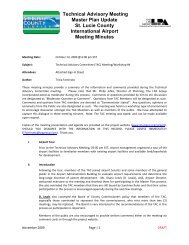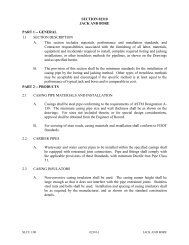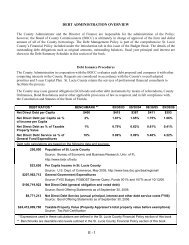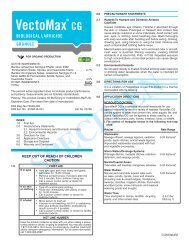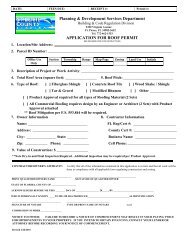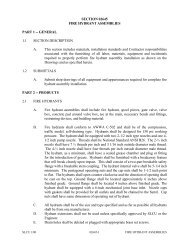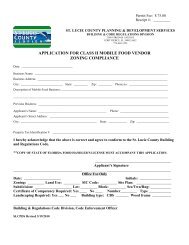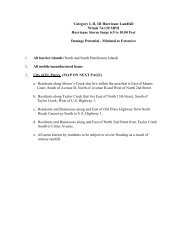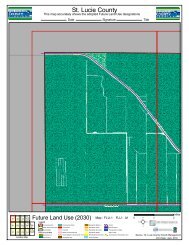Spruce Bluff Preserve Pioneer - St. Lucie County
Spruce Bluff Preserve Pioneer - St. Lucie County
Spruce Bluff Preserve Pioneer - St. Lucie County
You also want an ePaper? Increase the reach of your titles
YUMPU automatically turns print PDFs into web optimized ePapers that Google loves.
1) Land of Opportunity - After the Second Seminole War ended in<br />
1842, Congress passed the Armed Occupation Act. Any head of<br />
family or single man eighteen or over, was able to claim 160 acres of<br />
land, south of Cedar Key and Palatka, Florida. The law provided that<br />
he live on the land for five years and put at least five acres under<br />
cultivation. This Act enabled thousands of people to move to Florida<br />
to settle the region.<br />
2) Pineapples - During the late 1880's the pineapple cultivation<br />
rapidly became the leading industry of the region. Much of the<br />
pineapple was planted along the Indian River where the warm waters<br />
of the Atlantic ocean moderated the cold temperatures of winter.<br />
Warm winters, well drained soil were ideal for the crop.<br />
3) John Enos Fultz Jr., originally from South Carolina, founded a<br />
settlement at <strong>Spruce</strong> <strong>Bluff</strong> in 1889. His wife having died in Rockledge<br />
and his home destroyed by fire, he moved to homestead 160 acres on<br />
Winter Creek (about ½ mile south of where you are standing) in a two<br />
story house. Other settlers soon followed and included Curt<br />
Schroeder, Frank Waner, Jim Nailor, Jake<br />
Padget, Ed Winter, Captain Charles<br />
Blakeslee from Connecticut, and Harry Hill.<br />
Through the 1890's they tried pineapple<br />
farming, which was being done successfully<br />
all around <strong>St</strong>uart, Jensen and up toward Ft.<br />
Pierce, clearing the land to make their fortune<br />
in pineapples, much of which was transported<br />
to northern markets, such as New York.<br />
4) “<strong>Spruce</strong> <strong>Bluff</strong>” - In front of you is a Sand Pine. It’s thought that<br />
early residents called this tree <strong>Spruce</strong> Pine because it looked familiar<br />
to them. Was <strong>Spruce</strong> <strong>Bluff</strong> named after the tree of North Florida? Or<br />
because of the <strong>Spruce</strong> trees of their native Scandinavian homeland?<br />
5) Cold - Eventually the winter frosts affected the pineapples this far<br />
inland, away from the moderating effects of the Atlantic Ocean, in the<br />
crop production. In addition, they also planted citrus, which is more<br />
frost tolerant than pineapple to ensure an income. In order to meet the<br />
requirements of the homestead rule, settlers were required to plant<br />
gardens in addition to the necessity for survival.<br />
6) A Sawmill - William and Harley Crews came to <strong>Spruce</strong> <strong>Bluff</strong> in the<br />
late 1890's to run a sawmill to meet the lumber needs of the new<br />
community. Prior to the sawmill, lumber had to be imported from<br />
outside the region, quite a task considering that all cargo was ferried<br />
from the river using small schooners.<br />
7) Other Occupations - John Fultz rowed and sailed the <strong>St</strong>. <strong>Lucie</strong><br />
River to <strong>St</strong>uart and back, to deliver mail, was paid $10 a month. Harry<br />
Hill raised bees and promoted the production of honey in local<br />
newspapers. Hill soon moved to Ft. Pierce where he helped to<br />
establish the Florida Photographic Concern, who we owe for the photo<br />
preservation of the history of the surrounding area. With the arrival of<br />
the Florida East Coast Railroad in 1894 the area was beginning to<br />
boom. In 1895, Fort Pierce’s first doctor arrived.<br />
(The trail now turns right; follow the blue markings)<br />
8) Fire - Fire was a constant threat to the settlers. Summer lightning<br />
strikes and carelessness were threats to the many buildings of<br />
<strong>Spruce</strong> <strong>Bluff</strong>. Because there were no fire trucks back then residents<br />
relied on the good old bucket brigade system with water scooped<br />
from the river, shallow wells or ponds. These fire plow lines were<br />
made in the 1970's to stop a wildfire.<br />
9) Tough Times - Times were hard for the settlers. Measles,<br />
Malaria, Chickenpox, and difficulties during childbirth took its toll.<br />
Many died very young. Mosquitoes were a constant problem. They<br />
built crude cabins, some with oiled-paper windows because they<br />
couldn’t afford glass panes. There were no roads in the area. All<br />
supplies and saleable products came up from <strong>St</strong>uart or Rio in boats.<br />
Occasionally traveling ministers came down the coast on sailboats to<br />
preach to gatherings of settlers. <strong>Spruce</strong> <strong>Bluff</strong> eventually grew large<br />
enough to have a school and post office.<br />
10) Trouble Ahead - A freeze in the winter of 1894-95 killed most of<br />
the pineapples in the area. When the crop didn’t thrive, there were<br />
few options. Some settlers left, going to <strong>St</strong>uart or Ft. Pierce. Fultz<br />
moved north, by 1905 the original families had left <strong>Spruce</strong> <strong>Bluff</strong>.<br />
When <strong>St</strong>. <strong>Lucie</strong> <strong>County</strong> was formed in that same year, Fultz became<br />
the first clerk of the court and lived in Ft. Pierce with his second wife<br />
and family. He owned over 600 acres of <strong>Spruce</strong> <strong>Bluff</strong> when he died in<br />
1921. Today, very little is left of the small community. Blakeslee<br />
Creek and Winters Creek were named after the settlers and are<br />
located a short distance away.<br />
11) The Cemetery - This small cemetery contains the remains of 7<br />
residents of <strong>Spruce</strong> <strong>Bluff</strong> and is all that has survived of the settlement,<br />
identified by headstones were 6, which were vandalized and replaced<br />
with the marble monument.<br />
1. George Fultz; died July 16, 1906 (38 years old); Son of John and<br />
Sarah Fultz<br />
2. Gertrude Fultz Winter; July 6, 1906 (28 years old); Daughter of<br />
John and Sarah Fultz; Wife of Ed Winter<br />
3. Arnold Winter; Age 5 years; Son of Ed and Gertrude Winter<br />
4. Infant Girl Crews; Daughter of William Frank and Mary Fultz Winter<br />
Crews<br />
5. Infant Son of Charles D. Blakeslee<br />
6. An older Child; Son of Charles D. Blakeslee<br />
(Trail Continues across the road)<br />
12) Life on the River - All transportation of goods, commerce and<br />
settlers relied on steamboats that plied the waters of the Indian River<br />
from Titusville to Jupiter during the late 1880's. Most of southern<br />
Florida from Orlando south was underwater for a good portion of the<br />
year, making travel very difficult except by boat, and everything relied<br />
on them from fishing to transportation. Away from the Indian River,<br />
the homesteaders were no different, in that small personal row or sail<br />
boats were a necessity to survival. Edgartown (now known as Ft.<br />
Pierce) was a thriving community up the Indian River and by January<br />
29, 1888 was large enough for a post office to be established.<br />
(Continue to the right of the cemetery)<br />
13) $$$ - Life was difficult for the homesteaders. Many were poor,<br />
trying to make a living with the “free” land obtained from the Armed<br />
Occupation Act. Supplies were difficult or too expensive to purchase<br />
and obtain forcing most settlers to live off the land, using the plants<br />
available for daily survival. Rosemary - leaves of this plant were used<br />
as a spice in foods and steeped to make a tea. The oil from the plant<br />
was made into a perfume.<br />
14) Blueberry - Vaccinium spp. - The blueberry produces a berry<br />
that is rich in vitamins A and C and also used as dye for clothing.<br />
15) Deer Moss - Cladonis spp. - A ground lichen that is easily<br />
destroyed by foot traffic and may take up to 50 years to recover. In<br />
moist air they are soft and sponge-like, when dry, crisp and brittle. It<br />
was collected as fodder for cattle. Early pioneers believed that milk<br />
from cattle fed Deer Moss “becomes wholly cream” and their meat<br />
becomes particularly fat and sweet.<br />
16) Broomsedge - Andropogon glomeratus -Resembles a broom<br />
when flowering, the roots of the plant were used to relieve poison ivy<br />
itch. Next to the Broomsedge is Prickly pear cactus - Opuntia spp. -<br />
Once the thorns are removed, it was eaten raw.<br />
(The trail turns right on the pavement then turns left.)<br />
17) Wax Myrtle - Myrica cerifera - Produces a waxy berry that early<br />
settlers used in making candles. Leaves were used as a seasoning.<br />
It’s also thought to repel fleas, early settlers planted the shrub around<br />
their homes. Twigs were placed in closets or drawers to repel<br />
cockroaches. Bark from roots were dried and pulverized to treat<br />
colds, asthma, flu and chills. Tea from leaves were used to treat<br />
fevers, stomach aches and a gargle for sore throats.<br />
18) Pennyroyal - Piloblephis rigida - The leaves of the plant were<br />
put in a small bag and placed in a pets bed to repel fleas. The oil<br />
from the plant was used as an insect repellent. It also made a minty<br />
tea. Next to the pennyroyal is Pawpaw - Asimina reticulata - The fruit,<br />
fleshy and yellow when ripe, was used as a sauce or relish.<br />
19) Saw palmetto - Serenoa repens - Fruit when ripe, was a food<br />
source. Berries were used to relieve symptoms for colds, hay fever,<br />
asthma and bronchitis. A tea made from dried berries was used to<br />
build strength during recovery from illness.<br />
20) Gallberry - Ilex glabra - A very common species in Pine<br />
Flatwoods, the berries are an important wildlife food. Early settlers<br />
charred the leaves, steeped them in hot water to make a tasty tea.<br />
The plant produces a highly flavorful honey.<br />
21) Slash Pine - Pinus elliotti - Appropriately named, as it was<br />
oftentimes "slashed" for turpentine and rosins. The sap was gathered<br />
in clay pots nailed to the tree. Many of the older pines in the area still<br />
show the characteristic V shaped scars on the trunks. Early settlers<br />
used the wood extensively for home construction. The sap was also<br />
used as an antiseptic and expectorant.<br />
22) Goldenrod - Solidago - The flowers were used to produce a deep<br />
yellow dye for clothing. Leaves and flower tops were used to make<br />
herbal medicines for digestive, urinary problems, wounds, ulcers,<br />
cancers, dysentery, gout, colds, eczema and diarrhea.<br />
23) Oaks - Six different types of oaks are found in the area: Live Oak<br />
- Quercus virginiana, Sand Live Oak - (Q. geminata), Chapman's Oak<br />
- Q. chapmanii, Myrtle Oak - Q. myrtifolia , Runner Oak - Q. pumila<br />
and Scrub Oak - Q. inopina. Their wood was used for tools and<br />
furniture, tannins in their bark for medicines and tanning of animal<br />
skins, in addition to treating spider bites.<br />
24) Dahoon Holly - Ilex cassine—is a small tree that prefers wetter<br />
areas bordering marshes and swamps. It has a narrow growth habit of<br />
upward pointing branches. An evergreen species, it is easily<br />
distinguished by the leaves that have smooth margins with just a few<br />
small sharp teeth and a sharp bristle at the tip. This species is<br />
dioecious, meaning there are separate male and female trees. Female<br />
trees like this one are the ones that possess red berries, which are<br />
eaten by many songbirds.<br />
25) Carolina Willow - Salix caroliniana - Early settlers used the inner<br />
bark of the tree as a substitute for aspirin, relieving fever, chills,<br />
worms and even dandruff . Leaves, bark and seeds slowed the<br />
bleeding of wounds. The bark and leaves were used as a<br />
preventative treatment for malaria, as an anti-inflammatory, as well as<br />
arthritic and rheumatic conditions. Tea was made from leaves or buds<br />
to treat gangrene, eczema and cancer.<br />
26) Cattails - Typha - Widely used by settlers, all parts of the cattail<br />
are edible. Young shoots can be peeled and eaten raw or cooked like<br />
asparagus. The immature flower heads (while still green) can be<br />
boiled or eaten like corn on the cob. In winter, the roots were cooked<br />
like potatoes, or made into a white flour. The leaves were used to<br />
weave baskets, chair seats and backs.<br />
27) Spanish Moss - Tillandsia usneoides - Early settlers used the<br />
moss as mattress stuffing, as well as a bandaging material to<br />
promote healing of wounds.<br />
Thank you for the opportunity to learn about our first<br />
residents at <strong>Spruce</strong> <strong>Bluff</strong>. You may keep the<br />
pamphlet for future reference or return it to the<br />
pamphlet box for re-use.<br />
References;<br />
Martin <strong>County</strong>: by D.S. Hudson Fplib#FLC 917.5931 MAR<br />
(newcomers guide to Martin Co, 1973)<br />
www.floridata.com<br />
www.umd.umich.edu<br />
www.plantatlas.usf.edu
<strong>Spruce</strong> <strong>Bluff</strong> Natural Area is a 97 acre site consisting<br />
of mixed upland and wetland natural communities<br />
including; scrub, scrubby flatwoods, mesic flatwoods,<br />
baygall swamp and depression marsh. This natural area<br />
is nestled in the heart of a Port <strong>St</strong> <strong>Lucie</strong> neighborhood<br />
that lays along the banks of the <strong>St</strong> <strong>Lucie</strong> River. The<br />
property has two separate unique pasts; as it was once<br />
the site of a 1890’s pioneer settlement and is also home<br />
to one of the largest AIS Native American mounds in<br />
South Florida (dating back to pre-ceramic periods).<br />
There are two 1/2 mile interpretive trails leading from the<br />
parking area, each with a different take on these two<br />
very different settlements separated by time.<br />
The trail head and parking area is located off the north<br />
end of Southbend Blvd in Port <strong>St</strong>. <strong>Lucie</strong>, FL. From Port<br />
<strong>St</strong>. <strong>Lucie</strong> Blvd, head south on SE Floresta Dr, take a left<br />
at Southbend Blvd and the first left after the C-24 canal<br />
bridge onto Peru <strong>St</strong>. Travel 0.5 miles and take left onto<br />
Dar. The Parking area will be on your left.<br />
Guidelines and Safety Information:<br />
Be cautious of uneven trail surfaces<br />
Please remain on the trails.<br />
Carry adequate drinking water.<br />
In case of lightning, seek a low area away from trees,<br />
fence lines and tall objects.<br />
In case of emergency, call 911.<br />
While hiking the trail you may encounter animals<br />
indigenous to this area. Please observe from a safe<br />
distance.<br />
Leave all plant life intact.<br />
Please leave site cleaner than you found it.<br />
“Pack it in, pack it out.”<br />
Use at own risk.<br />
Info here within, is for educational purposes not for<br />
medicinal use.<br />
To learn more about <strong>St</strong>. <strong>Lucie</strong> <strong>County</strong>’s natural<br />
heritage, there are more than 20 self-guiding<br />
Interpretive trails located within the Natural Areas<br />
<strong>Preserve</strong>s. Each trail describes the most common plants,<br />
as well as significant geographical and Historical features<br />
of the site.<br />
Site purchased with funds from the South Florida Water<br />
Management District’s Save Our Rivers (SOR) Program and<br />
<strong>St</strong>. <strong>Lucie</strong> <strong>County</strong>’s Environmentally Significant Lands (ESL)<br />
Program.<br />
<strong>Spruce</strong> <strong>Bluff</strong><br />
North <strong>Pioneer</strong> Trail<br />
Interpretive Trail<br />
<strong>St</strong>. <strong>Lucie</strong> <strong>County</strong><br />
Environmental Resources<br />
Department<br />
2300 Virginia Avenue<br />
Ft. Pierce, FL 34982<br />
772-462-2526<br />
http://www.stlucieco.gov/erd/environmental_lands.htm<br />
Site Open: Sunrise to Sunset (11/11)


